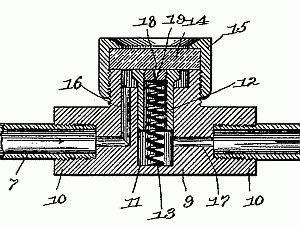|
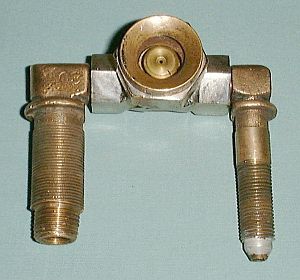 The winker assembly
(shown at left) provides an indication that steam cylinder oil is flowing to
the engine to lubricate the slide valves and pistons. Invented and
patented (patent number 694,406) on March 4, 1902 by Benjamin T. McCanna and
Thomas A. Delaney of Chicago, the device was assigned to and manufactured by
Hills-McCanna Company of Chicago. The origins of Hills-McCanna still
exist today as the McCanna Division of Worcester Controls manufacturing a
wide selection of industrial ball valves. The winker assembly
(shown at left) provides an indication that steam cylinder oil is flowing to
the engine to lubricate the slide valves and pistons. Invented and
patented (patent number 694,406) on March 4, 1902 by Benjamin T. McCanna and
Thomas A. Delaney of Chicago, the device was assigned to and manufactured by
Hills-McCanna Company of Chicago. The origins of Hills-McCanna still
exist today as the McCanna Division of Worcester Controls manufacturing a
wide selection of industrial ball valves.
Operation of the winker is simple.
When no oil is flowing the "eye" of the winker is clear showing the "iris"
as shown in the photo. When oil is passing through the winker the eye
turns dark as depicted in the photo to the right.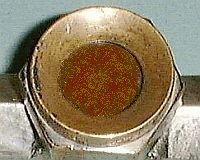
Oil flow from the power steam
cylinder oil pump is piped to the right leg of the winker. The left
leg of the winker is the discharge and which includes a standard ball and
spring check valve (shown in the disassembled view of the winker below).
The discharge from the winker is piped to a fitting tapped into the side of
the steam line which runs back to the engine.
The power steam oil pump is a piston
pump and thus pumps oil in pulses. It is this pulsing action of
pumping oil that causes the winker sight glass to alternate between fully
dark with oil and back to silvery again when no oil is present. As the
power steam oil pump's plunger is pushed into the pump by the pump drive oil
is discharged from the pump. That oil flows through tubing between the
pump and the winker and ends up flowing out a small port in the top surface
of the winker (the port is indicated by arrow 1 in the photo). That
oil fills a cavity between the glass and the body of the winker.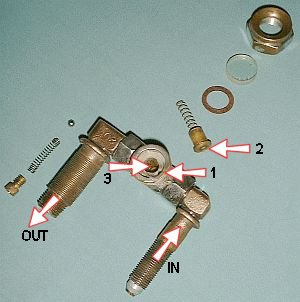
Pressed up against the glass is a
spring loaded plunger assembly that includes a small hole in the cap
(indicated by arrow 2 in the photo). As the oil fills the cavity the
pressure of the oil as exerted by the pump causes the plunger to compress
the spring and thus the plunger is pushed away from the back side of the
glass and the winker eye appears totally dark. Once the pump reaches
the end of its stroke no more oil is being pumped and the spring attempts to
push the plunger back against the glass. The small hole in the top
center of the plunger allows the oil to run past the plunger and into the
cavity below the plunger (indicated by arrow 3 in the photo). Once in
the cavity below the plunger the oil passes the check valve and runs to the
engine's steam supply pipe.
In the event that the throttle is
open the steam supply pipe to the engine will be under some level of steam
pressure. The check valve at the discharge of the winker prevents the
steam pressure from flowing back through the winker. In this case as
the oil passes through the hole in the plunger it builds pressure.
With each stroke of the power steam oil pump the pressure in the oil line
between the pump and the winker discharge check valve is increased.
The plunger continues its winking action but now only to equalize the
pressure between the pump and the plunger and the plunger and the check
valve. The discharge check valve in the power steam oil pump keeps the
oil pressure from leaking back through the steam oil pump. When the
pressure between the power steam oil pump and the winker check valve becomes
greater than the steam pressure in the steam line to the engine, the winker
discharge check valve opens and allows oil to pass through to the steam
pipe. Now with each successive pump of the power steam oil pump's
piston oil is delivered to the engine's steam supply line and the steam oil
system operates at the nominal pressure of the steam line to the engine.
As this pressure can be near the maximum boiler pressure of 600 PSIG, the
glass on the winker is 1/4" thick. When the throttle is closed and the
steam pressure in the engine's steam supply line decreases, the higher
pressure of the steam cylinder oil supply system is is equalized by the
action of the winker discharge check valve.
The winker pictured is from a
non-condensing Stanley were the check valve is located right at the
discharge of the winker. From the discharge of the check valve the oil
line went through the firewall and was attached to a fitting on the steam
line to the engine. For condensing Stanleys the check valve was
located near the connection of the steam cylinder oil line to the steam loop
and was not installed under the dash attached to the winker. See the
discussion on the steam cylinder oil check valve for additional information. |
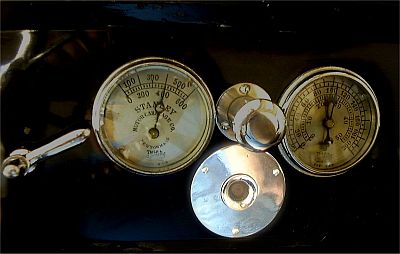
 The winker assembly
(shown at left) provides an indication that steam cylinder oil is flowing to
the engine to lubricate the slide valves and pistons. Invented and
patented (patent number 694,406) on March 4, 1902 by Benjamin T. McCanna and
Thomas A. Delaney of Chicago, the device was assigned to and manufactured by
Hills-McCanna Company of Chicago. The origins of Hills-McCanna still
exist today as the McCanna Division of Worcester Controls manufacturing a
wide selection of industrial ball valves.
The winker assembly
(shown at left) provides an indication that steam cylinder oil is flowing to
the engine to lubricate the slide valves and pistons. Invented and
patented (patent number 694,406) on March 4, 1902 by Benjamin T. McCanna and
Thomas A. Delaney of Chicago, the device was assigned to and manufactured by
Hills-McCanna Company of Chicago. The origins of Hills-McCanna still
exist today as the McCanna Division of Worcester Controls manufacturing a
wide selection of industrial ball valves.

